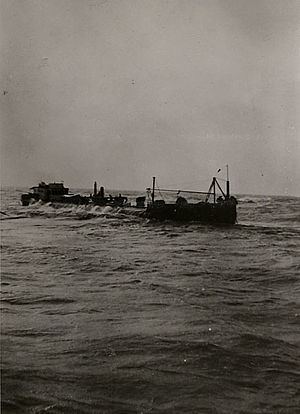In service 1935 Builder Horton Steel Works | Type steel tank barge | |
 | ||
Name Bruce Hudson’’ later ‘’Coastal Cliff, ‘’Witcroix’’ Identification Canadian registry #158658 Tonnage 452; increased to 753 in 1939; increased to 1,071 in 1947; increased to 1,319 in 1957 Length 164.2 ft (50 m); lengthened to 172 ft (52 m) in 1939; lengthened to 212.7 ft (65 m) in 1947; lengthened to 205.3 ft (63 m) in 1957 | ||
Bruce hudson ship top 12 facts
The Bruce Hudson was an oil tanker which mainly carried petroleum products on the North American Great Lakes. She was built in 1935 by the Horton Steel Works Ltd. of Fort Erie. Originally the Bruce Hudson, and sister ships, were unpowered tank barges, that relied on tugboats to tow them from port to port. This did not prove very workable. In July, 1935, the Bruce Hudson capsized in high seas off Cobourg, Ontario while being towed from Montreal to Port Credit, Ontario with a load of crude oil. She was towed upside-down to St. Catharines, Ontario, siphoned out, righted, and returned to service. In November, 1935, the crew of the Bruce Hudson were removed from the barge in high seas, again off Cobourg, when the tug Ethel ran low on fuel and had to leave the vessel adrift on Lake Ontario. The steamer Brulin took the barge in tow and won salvage fees in Exchequer Court of Canada.
In 1939 the vessel underwent the first of several refits. She was lengthened and had a pair of used engines added.
On July 26, 1943, while preparing to ship a highly volatile petroleum product called casinghead gas from East Chicago, Indiana the Bruce Hudson cargo exploded—sending flames shooting hundreds of feet in the air. Her Captain, his son, and two other crew members were horribly burned, and later died of their burns. Despite heavy damage to her superstructure, the Bruce Hudson was repaired and returned to service.
In 1947, the Bruce Hudson underwent a second refit, being lengthened and deepened in St. Catharines.
In 1948, the Bruce Hudson was sold to Transit Tankers & Terminals Ltd. of Montreal.
In August, 1951, the Bruce Hudson ran aground at Wellesley Island, New York in the Thousand Islands archipelago in the Saint Lawrence River.
In 1952, the Bruce Hudson was sold to Coastalake Tankers Ltd. and renamed Coastal Cliff.
In 1957, the Coastal Cliff underwent a third refit, being lengthened and re-engined in Montreal.
In 1969 the Coastal Cliff was sold to West Indies Transport and renamed Witcroix.
In 1983, the Witcroix was scrapped at Cartagena, Colombia.
